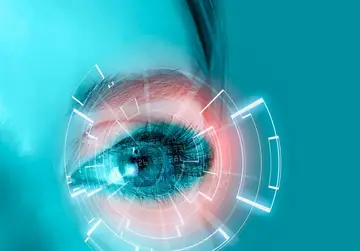Scientists Successfully Determine the Molecular Age of the Eye for the First Time

A study by a group of researchers has revealed the development of a "proteomic clock" using artificial intelligence (AI) that can predict age and show accelerated aging in specific diseases. They accomplished this by mapping nearly 6,000 proteins found in various cell types in the eye. Using data gathered from tiny drops of eye fluid systematically removed during surgery, the researchers created a proteomic clock that could potentially foresee an individual's age based on their protein expression.
This proteomic clock unraveled that certain diseases, such as diabetic retinopathy and uveitis, trigger expedited aging in specific cell types. Strikingly, the team also discovered proteins linked to Parkinson's disease in the eye fluid, potentially paving the way for earlier diagnosis of the condition.
Vinit Mahajan, the study's senior author, a surgeon, and a professor of ophthalmology at Stanford University says the eye’s unique trait is its transparency that allows the observation of developing diseases. However, the non-regenerative nature of the eye, like the brain, makes taking tissue biopsies in living patients difficult as it could cause irreparable damage. Therefore, an alternate method of liquid biopsies is used - extracting fluid samples from near the relevant cells or tissues.
Using a method to map protein production in different eye cells, Mahajan’s team distinguished 5,953 proteins from 120 liquid biopsies obtained during eye surgery - almost ten times the number characterized in earlier studies. They then used a software tool, TEMPO, to trace each protein to its specific cell types.
The research into the association between disease and molecular aging prompted the building of an AI machine learning model that can anticipate the molecular age of the eye based on 26 proteins. This model predicted age accurately for healthy eyes but found diseases were linked to dramatic molecular aging.
Diagnosis of Parkinson's disease is challenging as associated proteins are usually identified postmortem, and current diagnostic methods can't test for them. These proteins were detected in the eye fluid, potentially enabling earlier Parkinson's diagnosis and ongoing therapeutic monitoring.
The researchers suggest aging might be organ or cell-specific, potentially improving precision medicine and clinical trial design. Julian Wolf, first author, and ophthalmologist from Stanford University implies targeted anti-aging drugs may be the future of preventive, precision medicine. Mahajan reinforces the value of molecular characterization in patients to improve clinical trials, drug selection, and outcomes.
The research team plans to expand the study to include a larger number of patients and a broader range of eye diseases. They also believe their method could be applied to other difficult-to-sample tissues, potentially using liquid biopsies of cerebrospinal fluid to study the brain, synovial fluid for joints, and urine for the kidneys.
This research was supported by the National Institutes of Health, Stanford University, Research to Prevent Blindness, the VitreoRetinal Surgery Foundation, the Lundbeck Foundation, and the BrightFocus Foundation.




